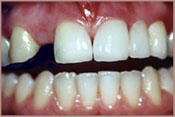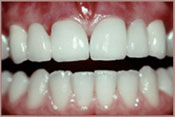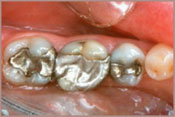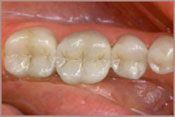Our practice can provide a wide range of dental services. We can typically provide every type of dental service without having to refer you to other specialties. This flexibility saves you time and keeps your total dental care within one practice. Our emphasis is on total preventive care for our patients. Total care begins with regular hygiene visits, regular check-ups and continued home oral health routines.
Our practice also provides the highest-quality services for restoring mouths that have been damaged by dental disease and injury and common problems that require cosmetic dentistry. Our primary goal for our patients is to achieve and maintain optimum oral health through advances in techniques, technologies and by maintaining their scheduled dental exams.
Crowns
A crown is a custom-made covering that fits over an original tooth that is either decayed, damaged or cracked. Crowns are made of a variety of different materials such as porcelain, gold, acrylic resin or a mix of these materials. Porcelain generally has the most natural appearance.
The treatment plan for a patient receiving a crown involves:
- Numbing the tooth to remove the decay in or around it.
- Re-sculpturing the tooth to provide an ideal fit for the crown.
- Making an impression of your teeth in order to create a custom-made crown (usually takes two weeks).
- Making a temporary crown out of acrylic resin and fitting it onto the tooth during the interim period when the custom-made crown is being created.
- Applying the permanent crown (when received from the lab) by removing the temporary crown and fitting the custom-made one onto the tooth.
- After ensuring that the crown has the proper look and fit, the dentist cements it into place.
- This process generally consists of a minimum of 2-3 visits over a three to four week period.
Once the procedure is completed, proper dental hygiene, including daily brushing and flossing, is required to maintain healthy, bacteria-free teeth, gums and crowns. This helps in the prevention of gum disease. Given proper care, your crowns can last a lifetime.
Bridges
A bridge is a dental device that fills a space that a tooth previously occupied.
A bridge may be necessary to prevent:
- Shifting of the teeth that can lead to bite problems (occlusion) and/or jaw problems and resultant periodontal disease.
- Bridges safeguard the integrity of existing teeth and help maintain a healthy, vibrant smile.
There are three main types of bridges, namely:
- Fixed bridge - This is the most popular and consists of a filler tooth that is attached to two crowns, which fit over the existing teeth and hold the bridge in place.
- The cantilever bridge is often used when there are teeth on only one side of the span. A typical three-unit cantilever bridge consists of two crowned teeth positioned next to each other on the same side of the missing tooth space. The filler tooth is then connected to the two crowned teeth, which extend into the missing tooth space or end.


Fillings
The concept of a "filling" is replacing and restoring your tooth structure that is damaged due to decay or fracture with a material. We will replace old, broken-down amalgam/metal fillings white fillings (composites) to restore your smile and teeth to a more natural look and feel.
With today's advancements, no longer will you have to suffer the embarrassment of unsightly silver fillings or metal margins of the past. Eliminate the dark, black appearance in your teeth with new-age, state-of-the-art, tooth-colored resin or porcelain materials.
Comparing White Fillings Versus Silver Amalgam Fillings:
- White fillings bond to the tooth; they strengthen the tooth by restoring most of its original shape. Silver amalgams, on the other hand, weaken the teeth and make them more susceptible to breaking. Broken teeth can be very expensive to replace; white composites can actually save time and money in the long run.
- White filling composites are preferred by most patients. This is due to the natural color, strength and overall appearance and feel. Composites are naturally more comfortable.
- Hot and cold sensitivity is greatly reduced with composite material compared to the silver amalgams.
- Restorations with composites require less removal of tooth, less structure to place than those with amalgams and especially with new cavities. Dramatically smaller holes are needed with a composite.


Root Canals
A root canal is a procedure that extracts decayed pulp from the central part of the tooth, reshapes the canal and replaces it with strengthening filler.
A cavity is the result of superficial decay of the enamel of the tooth. Left long enough, this decay can burrow into the deeper reaches of the tooth, causing extensive damage to tooth structure. When the damage goes beyond what can be treated with a filling, dentists can perform a root canal (or endodontics), preserving the tooth and retaining its original integrity; thereby, saving a tooth that in the past would have to have been pulled.
Procedure:
- The patient undergoes anesthesia.
- A dental dam is used to isolate the tooth.
- The tooth is opened to allow for removal of infected or dead dental pulp.
- The tooth is comprehensively cleaned, including any cracks and canals.
- With special tools, the doctor reshapes the canals.
- The tooth is filled again with cutting edge biocompatible filling material.
- A temporary covering is used to cover the access opening.
- Patients MUST see their regular dentist quickly for a permanent restoration of the tooth.

